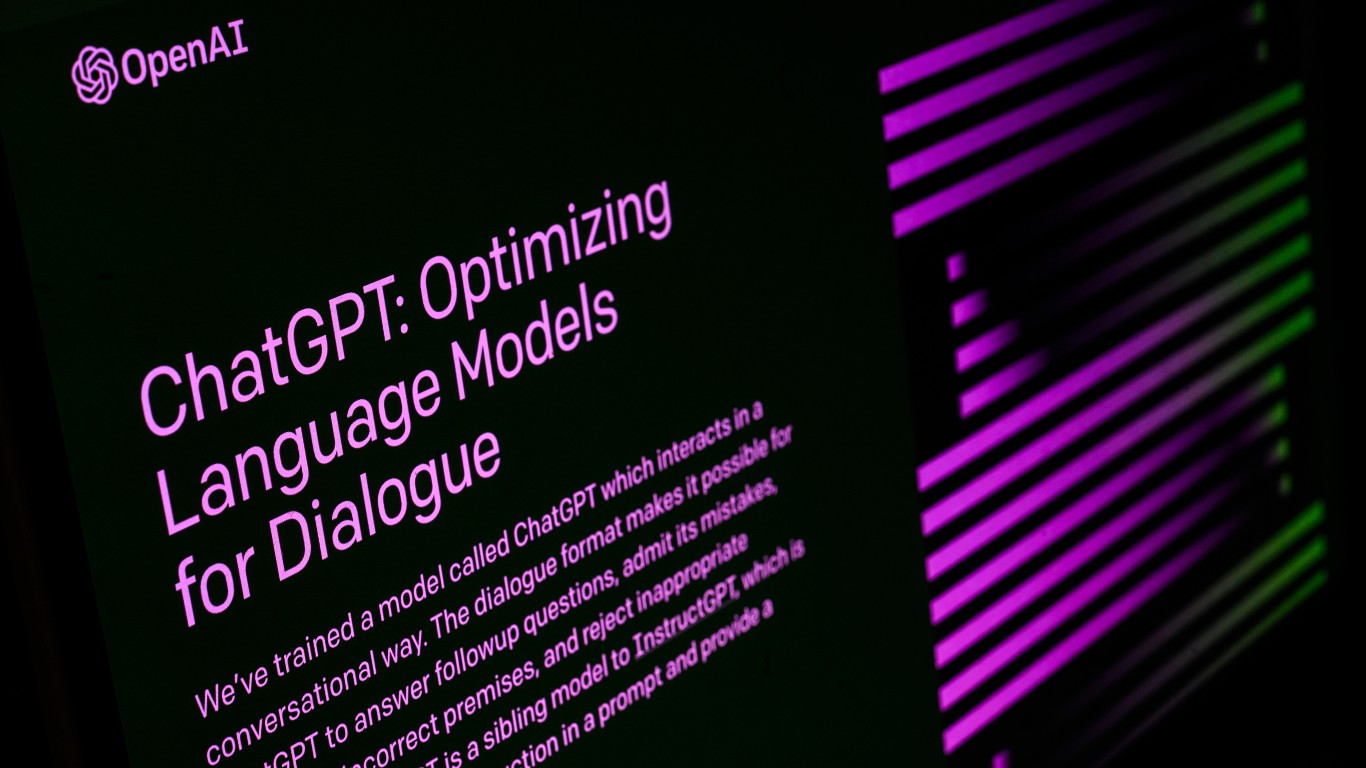Investing
The 20 Jobs Most Likely to Be Replaced or Changed by AI and Automation

Published:
Last Updated:

The rapid development of AI language models has already had a significant impact on various occupations and will likely have even more of an impact going forward. These models are designed to understand and respond to human language, enabling them to perform tasks traditionally handled by human workers and leading to their integration in a wide range of industries. Still, the influence of AI tools on different occupations varies greatly.
To find the occupations most exposed to AI technology, 24/7 Wall St. reviewed the study “How will Language Modelers like ChatGPT Affect Occupations and Industries?” published in March in Arxiv.org. Many of the most exposed occupations are teachers at colleges and universities. To show a wider range of occupations, we bundled all the postsecondary teacher categories into one category.
AI language models can assist postsecondary teachers in curriculum development, automating grading for assignments, and produce AI-powered virtual classrooms. The integration of AI technologies in the education sector would require educators to adapt their teaching methods and leverage AI tools. However, the role of postsecondary teachers remains vital in facilitating discussions, fostering critical thinking, and providing mentorship to students. (Find out if any of the deadliest jobs can be AI assisted – these are the 23 deadliest jobs in America.)
The legal field is also represented on the list. AI language models have proven useful for tasks such as contract analysis, legal research, and document generation and review. These models can sift through vast amounts of data and identify relevant information more quickly than humans. However, lawyers and judges possess intricate legal knowledge, critical thinking abilities, and the capacity to interpret the law in complex cases.
Many of the occupations on the list have relatively high pay and require advanced degrees, but not all. The projected occupation growth may not be taking AI technology fully into account and it would be interesting to compare it to next projections that fully consider AI.
While AI language models have undoubtedly transformed and automated certain aspects of the occupations on the list, they have not rendered human workers obsolete as often just a part of the job can be performed by AI technology. By delegating repetitive and mundane tasks to AI, human workers can focus on higher-level decision-making, creativity, problem-solving, and providing personalized services that require emotional intelligence and human connection. (Will more occupations become extinct? Here are jobs that used to be common but no longer exist.)
As AI language models continue to advance, it is crucial for workers in these occupations to adapt and acquire new skills that complement AI technologies and learn to work effectively alongside AI systems. Of course, AI language models have also impacted content creation and journalism, and this piece, in fact, was written with the assistance of ChatGPT.
Click here to see 20 jobs vulnerable to automation and AI takeover.

20. Teachers and Instructors, All Other
> Exposure: 1.486
> Mean annual wage: $66,450 – #236 highest of 649 occupations
> Employment: 120,480
> Projected employment growth, 2021-2031: 7.6%
> Min education requirement: Bachelor’s degree
As AI language models advance, teachers may leverage them to enhance content delivery and personalized learning. However, human teachers’ role in providing guidance, mentorship, and adapting to individual needs remains crucial.
[in-text-ad]

19. Historians
> Exposure: 1.491
> Mean annual wage: $72,900 – #189 highest of 649 occupations
> Employment: 3,120
> Projected employment growth, 2021-2031: 4.5%
> Min education requirement: Master’s degree
AI can aid historians in data analysis and research, but historians’ expertise lies in interpreting historical events, drawing connections, and offering context. The number of people working as historians and that could be affected by AI is relatively small.

18. Purchasing Agents, Except Wholesale, Retail, and Farm Products
> Exposure: 1.496
> Mean annual wage: $67,620 – #226 highest of 649 occupations
> Employment: 459,800
> Projected employment growth, 2021-2031: -2.0%
> Min education requirement: Bachelor’s degree
While AI streamlines procurement processes, purchasing agents bring expertise in negotiations, vendor relationships, and strategic decision-making. Their ability to assess market trends and find optimal solutions remains essential.

17. Door-To-Door Sales Workers, News and Street Vendors, and Related Workers
> Exposure: 1.511
> Mean annual wage: $36,280 – #582 highest of 649 occupations
> Employment: 8,640
> Projected employment growth, 2021-2031: -10.4%
> Min education requirement: No formal educational credential
With the advent of e-commerce and AI-driven marketing, the occupation faces challenges. Personalized sales interactions and direct engagement with customers remain key differentiators, though door-to-door sales workers require adaptability in a changing marketplace.
[in-text-ad-2]

16. Judicial Law Clerks
> Exposure: 1.513
> Mean annual wage: $66,310 – #238 highest of 649 occupations
> Employment: 15,540
> Projected employment growth, 2021-2031: -0.5%
> Min education requirement: Doctoral or professional degree
AI can assist judicial law clerks in legal research and document analysis. However, clerks provide essential support to judges by reviewing cases, drafting opinions, and conducting complex legal analysis.

15. Public Relations Specialists
> Exposure: 1.518
> Mean annual wage: $78,540 – #159 highest of 649 occupations
> Employment: 264,750
> Projected employment growth, 2021-2031: 8.1%
> Min education requirement: Bachelor’s degree
AI tools can aid public relations specialists in data analysis, sentiment monitoring, and content creation. However, specialists provide strategic communication, media relations, and brand management expertise for effective messaging and reputation management.
[in-text-ad]

14. Mental Health Counselors
> Exposure: 1.537
> Mean annual wage: $49,710 – #398 highest of 649 occupations
> Employment: 351,000
> Projected employment growth, 2021-2031: 11.0%
> Min education requirement: Master’s degree
While AI-based mental health tools can assist in assessments, counselors offer personalized therapeutic interventions, empathy, and human connection. Their expertise in diagnosing, treating, and supporting individuals with mental health issues remains vital.

13. Education Administrators, Postsecondary
> Exposure: 1.545
> Mean annual wage: $115,180 – #55 highest of 649 occupations
> Employment: 167,060
> Projected employment growth, 2021-2031: 7.4%
> Min education requirement: Master’s degree
AI can support education administrators in data management, analytics, and resource allocation. However, administrators bring strategic planning, and student-centered decision-making to shape the overall educational experience.

12. Credit Authorizers, Checkers, and Clerks
> Exposure: 1.546
> Mean annual wage: $46,180 – #450 highest of 649 occupations
> Employment: 16,290
> Projected employment growth, 2021-2031: -3.9%
> Min education requirement: High school diploma or equivalent
AI can assist these professionals with credit checks and verification to help manage risks and ensure compliance.
[in-text-ad-2]

11. Administrative Law Judges, Adjudicators, and Hearing Officers
> Exposure: 1.547
> Mean annual wage: $97,250 – #93 highest of 649 occupations
> Employment: 12,490
> Projected employment growth, 2021-2031: -2.8%
> Min education requirement: Doctoral or professional degree
While AI can aid in legal research, administrative law judges bring impartiality and decision-making skills to ensure fair hearings and resolve disputes. These judges’ role in interpreting and applying laws in administrative proceedings is indispensable.

10. Management Analysts
> Exposure: 1.548
> Mean annual wage: $104,660 – #73 highest of 649 occupations
> Employment: 808,860
> Projected employment growth, 2021-2031: 11.4%
> Min education requirement: Bachelor’s degree
Management analysts help organizations improve efficiency and solve problems. While AI can generate insights, analysts provide expertise in strategic decision-making, change management, and organizational development.
[in-text-ad]

9. Human Resources Specialists
> Exposure: 1.557
> Mean annual wage: $73,080 – #187 highest of 649 occupations
> Employment: 835,360
> Projected employment growth, 2021-2031: 7.5%
> Min education requirement: Bachelor’s degree
HR specialists manage employee relations, recruitment, and training. AI can support them in tasks like candidate screening and data management. However, HR specialists bring interpersonal skills, employee relations expertise, and knowledge of employment laws and contribute to talent acquisition, development, and maintaining a positive work environment.

8. Procurement Clerks
> Exposure: 1.590
> Mean annual wage: $46,560 – #445 highest of 649 occupations
> Employment: 63,340
> Projected employment growth, 2021-2031: -6.8%
> Min education requirement: High school diploma or equivalent
Procurement clerks handle purchasing and supply chain tasks. While AI can automate certain processes, clerks handle vendor relationships, negotiate contracts, and ensure smooth operations.

7. Clinical, Counseling, and School Psychologists
> Exposure: 1.626
> Mean annual wage: $102,740 – #77 highest of 649 occupations
> Employment: 62,880
> Projected employment growth, 2021-2031: 9.9%
> Min education requirement: Doctoral or professional degree
Psychologists provide mental health support and therapy. AI tools can assist in assessments, but psychologists offer personalized care, empathy, and therapeutic interventions.
[in-text-ad-2]

6. Judges, Magistrate Judges, and Magistrates
> Exposure: 1.646
> Mean annual wage: $153,700 – #17 highest of 649 occupations
> Employment: 28,230
> Projected employment growth, 2021-2031: -0.6%
> Min education requirement: Doctoral or professional degree
Judges make critical legal decisions that can be assisted by AI-based research. However, their role of interpreting laws, weighing evidence, and ensuring justice remains essential.

5. Arbitrators, Mediators, and Conciliators
> Exposure: 1.647
> Mean annual wage: $98,920 – #88 highest of 649 occupations
> Employment: 7,780
> Projected employment growth, 2021-2031: 6.2%
> Min education requirement: Bachelor’s degree
These professionals help resolve conflicts and disputes. While AI can provide information to aid in dispute resolution, human arbitrators bring negotiation skills and creative solutions.
[in-text-ad]

4. Political Scientists
> Exposure: 1.687
> Mean annual wage: $126,140 – #40 highest of 649 occupations
> Employment: 5,660
> Projected employment growth, 2021-2031: 6.2%
> Min education requirement: Master’s degree
Political scientists analyze political systems, policies, and behavior. Their expertise complements AI’s data analysis capabilities, providing nuanced interpretations and predictions.

3. Sociologists
> Exposure: 1.747
> Mean annual wage: $101,310 – #80 highest of 649 occupations
> Employment: 2,980
> Projected employment growth, 2021-2031: 5.4%
> Min education requirement: Master’s degree
Sociologists study human behavior, social structures, and relationships. While AI can aid in data analysis, sociologists offer critical insights into complex social issues.

2. All Teachers, Postsecondary
> Exposure: 1.857 – 0.39
> Mean annual wage: $65,500 to $133,950 – #28-277 highest of 649 occupations
> Employment: 1,149,570
> Projected employment growth, 2021-2031: 1.8%-24.1%
> Min education requirement: Doctoral or professional degree
Postsecondary teachers play a crucial role in higher education. While AI language models can assist with content delivery as teachers integrate the technology into their teaching methods, teachers provide personalized guidance, foster critical thinking, and facilitate discussions.
[in-text-ad-2]

1. Telemarketers
> Exposure: 1.926
> Mean annual wage: $33,600 – #615 highest of 649 occupations
> Employment: 96,520
> Projected employment growth, 2021-2031: -18.2%
> Min education requirement: No formal educational credential
Telemarketers engage in phone-based sales and marketing activities. With the rise of AI language models, they may face challenges as automated systems can handle customer interactions.
Methodology
To find the occupations most exposed to AI technology, 24/7 Wall St. reviewed the study “How will Language Modelers like ChatGPT Affect Occupations and Industries?” published in March in Arxiv.org. Many of the most exposed occupations are postsecondary teachers. To provide more variety, we bundled all the postsecondary teacher categories. All other data is from the Bureau of Labor Statistics’ Occupational Employment and Wage Statistics May 2022. The codes used in the study for some occupations have changed and when that was the case we used the new code or May 2021 data from O*Net, the Occupational Information Network sponsored by the U.S. Department of Labor.
Credit card companies are at war, handing out free rewards and benefits to win the best customers. A good cash back card can be worth thousands of dollars a year in free money, not to mention other perks like travel, insurance, and access to fancy lounges. See our top picks for the best credit cards today. You won’t want to miss some of these offers.
Flywheel Publishing has partnered with CardRatings for our coverage of credit card products. Flywheel Publishing and CardRatings may receive a commission from card issuers.
Thank you for reading! Have some feedback for us?
Contact the 24/7 Wall St. editorial team.